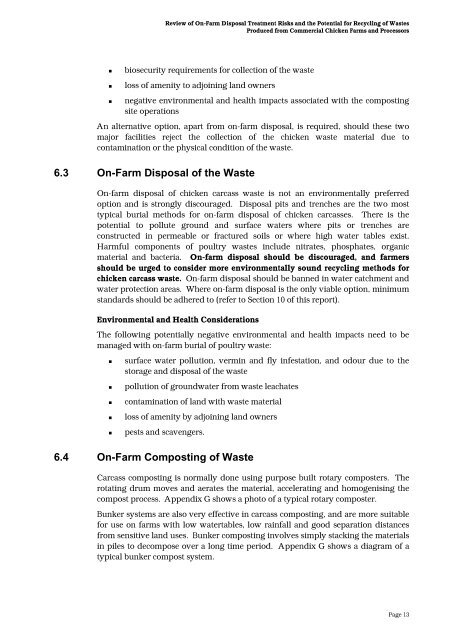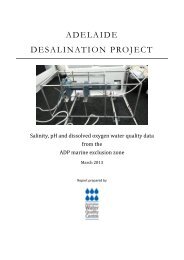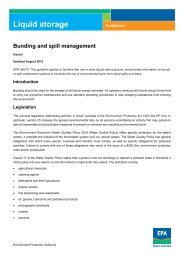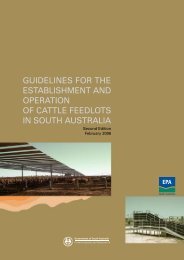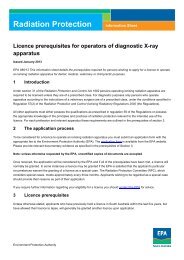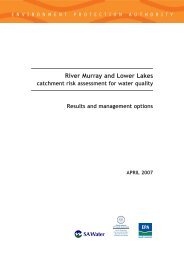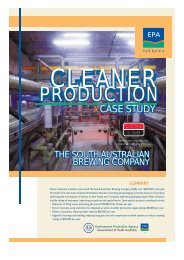Commercial Chicken Farms and Processors - EPA
Commercial Chicken Farms and Processors - EPA
Commercial Chicken Farms and Processors - EPA
You also want an ePaper? Increase the reach of your titles
YUMPU automatically turns print PDFs into web optimized ePapers that Google loves.
Review of On-Farm Disposal Treatment Risks <strong>and</strong> the Potential for Recycling of Wastes<br />
Produced from <strong>Commercial</strong> <strong>Chicken</strong> <strong>Farms</strong> <strong>and</strong> <strong>Processors</strong><br />
¢ biosecurity requirements for collection of the waste<br />
¢ loss of amenity to adjoining l<strong>and</strong> owners<br />
¢ negative environmental <strong>and</strong> health impacts associated with the composting<br />
site operations<br />
An alternative option, apart from on-farm disposal, is required, should these two<br />
major facilities reject the collection of the chicken waste material due to<br />
contamination or the physical condition of the waste.<br />
6.3 On-Farm Disposal of the Waste<br />
On-farm disposal of chicken carcass waste is not an environmentally preferred<br />
option <strong>and</strong> is strongly discouraged. Disposal pits <strong>and</strong> trenches are the two most<br />
typical burial methods for on-farm disposal of chicken carcasses. There is the<br />
potential to pollute ground <strong>and</strong> surface waters where pits or trenches are<br />
constructed in permeable or fractured soils or where high water tables exist.<br />
Harmful components of poultry wastes include nitrates, phosphates, organic<br />
material <strong>and</strong> bacteria. On-farm disposal should be discouraged, <strong>and</strong> farmers<br />
should be urged to consider more environmentally sound recycling methods for<br />
chicken carcass waste. On-farm disposal should be banned in water catchment <strong>and</strong><br />
water protection areas. Where on-farm disposal is the only viable option, minimum<br />
st<strong>and</strong>ards should be adhered to (refer to Section 10 of this report).<br />
Environmental <strong>and</strong> Health Considerations<br />
The following potentially negative environmental <strong>and</strong> health impacts need to be<br />
managed with on-farm burial of poultry waste:<br />
¢ surface water pollution, vermin <strong>and</strong> fly infestation, <strong>and</strong> odour due to the<br />
storage <strong>and</strong> disposal of the waste<br />
¢ pollution of groundwater from waste leachates<br />
¢ contamination of l<strong>and</strong> with waste material<br />
¢ loss of amenity by adjoining l<strong>and</strong> owners<br />
¢ pests <strong>and</strong> scavengers.<br />
6.4 On-Farm Composting of Waste<br />
Carcass composting is normally done using purpose built rotary composters. The<br />
rotating drum moves <strong>and</strong> aerates the material, accelerating <strong>and</strong> homogenising the<br />
compost process. Appendix G shows a photo of a typical rotary composter.<br />
Bunker systems are also very effective in carcass composting, <strong>and</strong> are more suitable<br />
for use on farms with low watertables, low rainfall <strong>and</strong> good separation distances<br />
from sensitive l<strong>and</strong> uses. Bunker composting involves simply stacking the materials<br />
in piles to decompose over a long time period. Appendix G shows a diagram of a<br />
typical bunker compost system.<br />
Page 13


